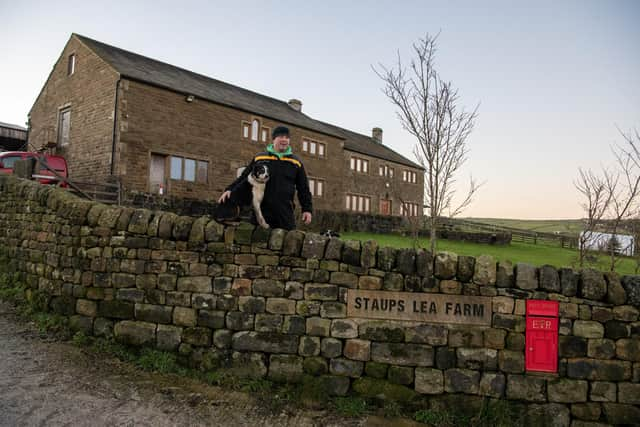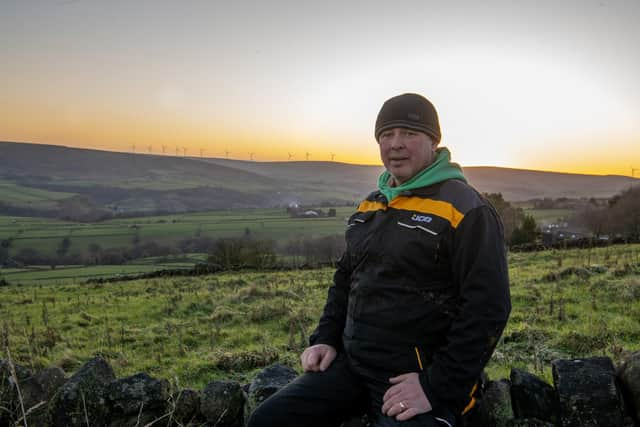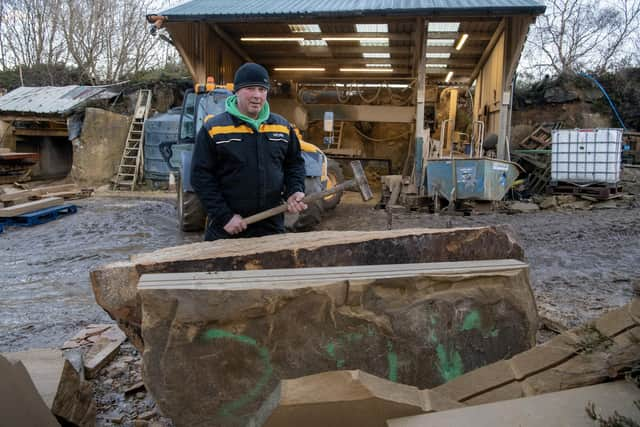Farm of the Week: Fulfilling a childhood dream by building a farm from scratch in the Yorkshire borderlands
What he started with thirty-nine years ago led him to having enough money to buy his own little farm at 18 and although today he now earns more from his civil engineering work in maintaining wind farms and from the millstone grit quarry he and his wife Sally took over from her stepfather, Jonathan still holds farming dear to his heart and farms 250 acres with a suckler herd of three-quarter British Blonde bred cows and a flock of 100 breeding ewes.
“When I was eleven dad bought a smallholding, just 1,200 yards from where we live now. I was messing around, as a kid, helping on a local farm and I really enjoyed looking after animals, and particularly liked being around cows and calves.
Advertisement
Hide AdAdvertisement
Hide Ad“I also noticed this guy sold his calves at three weeks old and found out they were bought by people who reared them on, then sold them and made some money. I fancied buying a couple and giving it a try. We had the smallholding where we could keep them. My mum helped me buy a couple of three-week old calves, she leant me £50. I reared them for a year and then sold them. The farmer I’d been working for, Ronald Sutcliffe, sold them for me at market.


“I then bought four with the money I’d made, and sold them. Next year I bought eight. It snowballed from that. Dad didn’t get involved until I was about 15 or 16, and by then I’d got a herd and needed some help. I’d got up to 12 suckler cows.
“By the time I was 18 I’d made enough to buy some land. It was 12 acres and it is where Sally and I live now. I bought my first house in Colden Valley nearby and when Sally and I met around 20 years ago we decided we’d really like to live here on the farm, so we built our own house here. I’ve only ever really moved a mile in my whole life.
Jonathan says building up Staups Lea Farm was easier than building the house.
Advertisement
Hide AdAdvertisement
Hide Ad“Getting some kind of property allowed here took quite a few years. We lived in two static caravans together for 5-6 years while we got planning permission sorted and then built this farmhouse in 2010 and that’s when it became a brand new farm with farmhouse on what was a greenfield site.


“We’ve bought additional land around us over the years as the farm has grown and part of the 250 acres is a separate farm of 110 acres just under Stoodley Pike across the valley where the cattle go in summer. Overall, we are now about 50 per cent owned and 50 per cent rented.”
Jonathan shifted to using a British Blonde bull for ease of calving after having had a run of bad calvings.
“We’ve a suckler herd of 22 cows that are all three-quarter British Blonde and we have nine heifers that are seven-eighth British Blonde coming on for bulling. We went into British Blonde with a pedigree bull because of easy calving and because they are a little bit quieter than Limousins. We’d had run of bad calving with Blues. We keep our own replacements and run the rest through winter, keeping that well so that there isn’t a lot of fattening to be done when we sell them in spring at Gisburn livestock market at around 11-12 months, so they can go straight out to grass. I find that at that time they usually get a better price.
Advertisement
Hide AdAdvertisement
Hide Ad“We’ve just sold two breeding bulls at Gisburn and I’ve just bought another bloodline from pedigree breeder Thor Atkinson of Ulverston who shows his stock and has a Blonde bull that has been around winning at all the shows last summer.


“I’ve also just bought a few stores out of Gisburn to rear on, but as a rule I don’t.
Jonathan says that the farm’s busiest time is in April as lambing and calving take place at the same time.
“We have 100 breeding ewes and 50 gimmer lambs coming on. They are all Swaledales and Mules, putting the Bluefaced Leicester tup to the Swaledale. We also sell the sheep through Gisburn usually. Lambing starts from 1 April.
Advertisement
Hide AdAdvertisement
Hide AdStaups Lea is in Mid-Tier Stewardship and Jonathan says that as part of that he’s just entering a scheme ensuring dirty water does not contaminate clean water and he has an agent currently looking into the new SFI schemes on his behalf. He has never lost his love of farming but says it is no longer the main earner it was for him as a schoolkid.
“Farming has always been my passion but the majority of my earning now comes from the civil engineering work and the quarry. The farm washes its face though and I still love my cattle.
“The civil engineering just fell on me. I had a guy looking for a tractor one day to take bog mats on to a moor where his digger had got stuck on the site of a wind farm. I helped him and as a result he asked if I fancied driving my tractor and fuelling up the excavators all day? I sent a man to do it. Then he wanted a digger, another digger, another man. From June to Christmas that year I ended up with 12 lads, 3 tractors and 4 excavators on this site.
“After the site was finished I followed the company around the country to other wind farms being set up, and then the client of the wind farm we’d worked on first got in touch and asked whether I’d be interested in maintaining it. They are Crook Hill and Reaps Moss wind farms. You can see them on the skyline from my house. We have a few others to look after and we’ve now been doing it 10 years.
Advertisement
Hide AdAdvertisement
Hide AdMillstone grit is an important building material in the Upper Calder Valley, nearly all houses are made from it and Jonathan and Sally’s quarry was owned by her stepfather Jim Gault.
“Jim retired in 2018 and was going to lock the gates, shut the quarry and walk away. We thought it was too good a business to shut so we took it on. We only take what we need for our orders each year, which isn’t an awful lot, maybe 150-200 tonnes as a lot of our work is restoration stuff like fireplaces, and we supply one or two new builds.
One of the funnier sights at Staups Lea is groups of often hapless, helpless and hopeless people trying to herd sheep, says Jonathan.
“My sister in law Amy has a company called Splat Training in our barn next door and runs team building exercises, one of which is to work together to get sheep through different hurdles. My sheep get very dizzy by the end of the day.